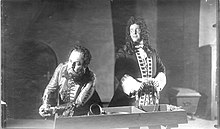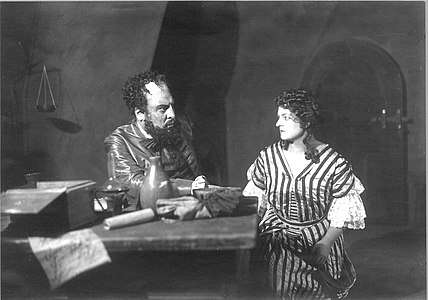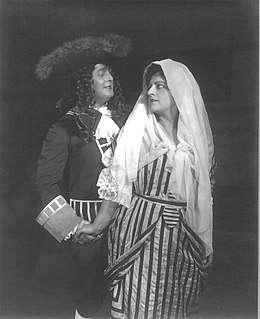Cardillac
Cardillac, Op. 39, is an opera by Paul Hindemith in three acts and four scenes. Ferdinand Lion wrote the libretto based on characters from the short story Das Fräulein von Scuderi by E. T. A. Hoffmann.
| Cardillac | |
|---|---|
| Opera by Paul Hindemith | |
 The composer in 1923 | |
| Librettist | Ferdinand Lion |
| Language | German |
| Based on | Das Fräulein von Scuderi by E. T. A. Hoffmann |
| Premiere | |
Performance history
The first performance was at the Staatsoper, Dresden, on 9 November 1926. It was promptly performed throughout Germany.[1] The opera's Italian premiere took place in 1948 at the Venice Biennale as part of the Venice Festival of Contemporary Music XI.[2]
Although Britain had to wait until 1970 for a staged performance, a concert performance was presented at the Queen's Hall, London, on 18 December 1936, with the BBC Symphony Orchestra conducted by Clarence Raybould, and starring Miriam Licette as Cardillac's daughter.[3][4]
Hindemith revised both the score and the text, for the reason that, according to Ian Kemp, the musical idiom "seemed crude and undisciplined".[5] This second version was first performed at the Zurich Stadttheater on 20 June 1952. Hans-Ludwig Schilling has published a comparison of the two versions.[6] After 1953, Hindemith sanctioned only the 1952 revised version for theatrical performances. However, after the composer's death in 1963, the original version became available again for production.[7]
The American premiere took place at the Santa Fe Opera in 1967 using a staging by director Bodo Igesz.[8] The New Opera Company presented the first staged UK performances in March 1970 at Sadler's Wells.[9]
Roles



| Role | Voice type | Premiere cast, 9 November 1926[10] (Conductor: Fritz Busch[11]) |
|---|---|---|
| Cardillac, the goldsmith | baritone | Robert Burg |
| Cardillac's daughter | soprano | Claire Born |
| The officer | tenor | Max Hirzel |
| The gold merchant | bass | Adolph Schoepfin |
| The courtier (cavalier) | tenor | Ludwig Max Eybisch |
| The lady | soprano | Grete Merrem-Nikisch |
| Provost marshal | bass | Paul Schöffler |
Synopsis
The setting is Paris in the 17th century.
Act 1
Scene 1
The crowd is agitated about a series of recent mysterious murders. The police calm the crowd. The goldsmith Cardillac enters the scene and the atmosphere becomes hushed. The Lady asks the Cavalier about the goldsmith Cardillac, and the Cavalier tells of the goldsmith and his priceless jewelry. The Lady promises the Cavalier a tryst that evening if he can bring her Cardillac's most beautiful work.
Scene 2
The Lady and the Cavalier enjoy their tryst and the Cavalier delivers one of Cardillac's belts. A masked figure steals into the bedroom and fatally stabs the Cavalier. The Lady faints and the mysterious figure leaves with the belt.
Act 2
The Gold Merchant mentions to Cardillac the latest murder that involved the theft of a recent work of Cardillac. The Gold Merchant has his suspicions about the identity of the murderer. Cardillac orders his daughter to watch over his work. She does so and awaits her lover, the Officer. Cardillac returns, and it becomes clear that he values the articles he has crafted more than he does his daughter. He then meets the King and offers to create his greatest work of art for him. The Officer enters to ask Cardillac for his daughter's hand in marriage, and Cardillac consents. Though the Officer realizes how much Cardillac values his creations over his own daughter, he offers money for one of the goldsmith's chains. After the Officer leaves, Cardillac indicates that he himself is the murderer.
Act 3
In a tavern, the Officer wears the chain, presenting himself as a target for the murderer. Cardillac enters and wounds the Officer, but the Officer beats back the attack and holds on to the chain. He advises Cardillac to flee. The Gold Merchant then brings on a crowd and accuses Cardillac of the murders. Cardillac is brought in, followed by his daughter. The Officer defends Cardillac, rebuts the Gold Merchant's accusation, and accuses the Gold Merchant of being the murderer's accomplice. In the ensuing ensemble, Cardillac's daughter realizes her father is the murderer. The crowd sings Cardillac's praises, but as they continue, his words make them wonder about the identity of the murderer. Finally, Cardillac reveals to the crowd that he is the murderer. They demand he repent his crimes, but he makes no such gesture. The crowd then lynches Cardillac. With his final gesture before dying, he reaches out for the chain around the Officer's neck, not his daughter. The Officer and Cardillac's daughter swear mutual devotion.
Recordings
- Joseph Keilberth, conductor; Dietrich Fischer-Dieskau, Leonore Kirschstein, Donald Grobe, Karl-Christian Kohn, Eberhard Katz, Elisabeth Söderström, Willi Nett; Cologne Radio Choir; Cologne Radio Symphony Orchestra; (Deutsche Grammophon). This recording is of the original 1926 version.
- Gerd Albrecht, conductor; Siegmund Nimsgern, Verena Schweizer, Robert Schunk, Harald Stamm, Josef Protschka, Gabriele Schnaut, Andreas Schmidt; backed-up RIAS Chamber Choir; Berlin Radio Symphony Orchestra; (Wergo, (1988)). This recording is of the original 1926 version.
- Kent Nagano, conductor; Alan Held, Angela Denoke, Christopher Ventris, Hannah Esther Minutillo, Charles Workman; orchestra and chorus of the Opera National de Paris; Bel Air Classiques, (2007). This recording is of the original 1926 version.
- Wolfgang Sawallisch, conductor; Donald McIntyre, Robert Schunk, Maria de Francesca-Cavazza, Hans Günther Nöcker; Chorus of the Bavarian State Opera, Bavarian State Orchestra; Staged and designed by Jean-Pierre Ponnelle; DVD (2008). This recording is of the original 1926 version.
References
- Chris Walton, Othmar Schoeck: Life and Works (Rochester, New York: University of Rochester Press, 2009), 153
- La Divina Maria Callas: "A 'divine' love between Maria Callas and Venice" Archived February 1, 2010, at the Wayback Machine, accessed 2 May 2010
- Music Web International: Miriam Licette, Charles A Hooey
- Encyclopedia.com: Michael Kennedy and Joyce Bourne, "Cardillac", The Concise Oxford Dictionary of Music 1996, accessed May 2, 2010
- Ian Kemp, "Hindemith's Cardillac". The Musical Times, pp. 268–269, 271 (1970).
- Review of "Paul Hindemiths Cardillac. Beiträge zu einem Vergleich der beiden Opernfassungen-Stilkriterien im Schaffen Hindemiths", Music & Letters, pp. 288–291 (1963)
- Muriel Hebert Wolf, "Review of Cardillac: Paul Hindemith", The Opera Quarterly, 1, pp. 133–134 (1983).
- Cragg Hines, "Another reason to visit Santa Fe: the opera", Houston Chronicle, 10 January 2007
- Winton Dean, "Music in London: Cardillac", The Musical Times, pp. 514–515 (1970)
- Casaglia, Gherardo (2005)."Cardillac, 9 November 1926". L'Almanacco di Gherardo Casaglia (in Italian).
- Schott Music: Cardillac, accessed May 2, 2010
Further reading
- Holden, Amanda (Ed.), The New Penguin Opera Guide, New York: Penguin Putnam, 2001. ISBN 0-14-029312-4
External links
- Cardillac: Scores at the International Music Score Library Project (IMSLP)
- Work details, hindemith.info